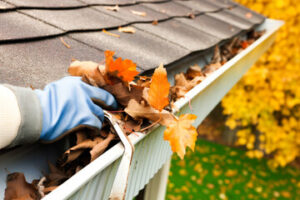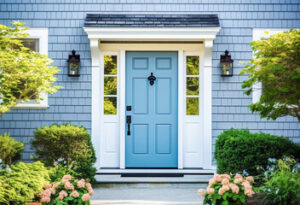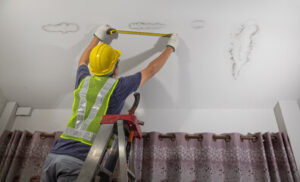Gutter Cleaning Charleston SC is a vital part of home maintenance. Left unchecked, clogged gutters can cause serious problems including staining and damage to the home.

Depending on the number of trees in your yard and your location, you should clean your gutters 2-4 times per year. Start near a downspout and work your way around, scooping debris into a bucket or on a tarp.
Gutters help direct rainwater away from the foundation, walls, and roof of your house. However, if they become overflowing or clogged with leaves, twigs, and debris, water can flow over the gutters and accumulate around the home. Over time, this can cause damage and even crack the foundation. Gutter cleaning helps prevent these problems by ensuring that water flows freely through the gutters and downspouts.
Gutter systems need to be cleaned regularly to keep them functioning as intended. If a homeowner neglects this important task, they are at risk of costly home repairs and foundation damage. To avoid this, the best course of action is to clean gutters twice a year – once in the spring and again in the fall.
To clean a gutter system, start by using a wet/dry vacuum or gutter cleaner with a hose attachment to suck up the gunk. Make sure the nozzle of the hose is set to a medium-level flow, similar to what you’d use when watering your garden. Next, attach the wand to the hose and carefully insert it into the gutter. Work it into the clog, twisting and turning as you go to break apart any clumps. When you’re done, turn off the vacuum and disconnect the hose.
If you don’t have a wet/dry vacuum, you can also use a ladder and a bucket to collect the debris for disposal. However, it’s generally safer and more effective to hire a professional gutter cleaning service. Professionals can use a variety of tools to remove large debris and clogs, including a ladder stabilizer, leaf blowers, air compressors, and a plumber’s snake. They can also help clear out clogged downspouts by working the end of the snake into the clog until it breaks apart or comes out. After removing all the debris, they will flush the gutters and downspouts with a garden hose to ensure that they are free of clogs and properly draining.
Finally, a professional will realign the gutters with the chalk line they drew earlier. This is especially important for homes with multiple-story buildings, as they may need to work from a ladder or other elevated vantage point. They will also check that the gutters are secured to the fascia or wall, and if necessary, will drill or pry out any nails or screws in the brackets and reattach them if needed.
Equipment
Gutter cleaning is an important part of home maintenance, and regular service prevents water damage to the roof and foundation. But it’s not always a simple task, especially when debris gets stuck in the gutters or is too heavy for downspouts to carry. Thankfully, there are many different gutter tools that can make the process much more efficient and less stressful.
Many of these gutter cleaning tools are designed to be used with a power washer, allowing you to rinse away loose dirt and debris using the high-powered stream of water. They’re available in a range of lengths, allowing you to reach even the hardest-to-reach spots. They’re also easy to use and ideal for those who don’t feel comfortable climbing a ladder or are unable to do so due to health reasons.
Other tools that are useful for gutter cleaning include telescoping systems that allow you to clean your gutters from the ground without having to climb a ladder. These systems typically come with a long, wand-like attachment that can be used to suck debris out of your gutters. They’re especially handy in the fall when dry leaves build up in your gutters.
If you’re looking for a more basic option, gutter scoops are another popular choice. These simple-to-use tools are designed to be affixed to the end of an extension pole, giving you a quick and easy way to remove wet leaves and dirt from your gutters. Many are made of durable metal and are available in various sizes to fit a variety of gutters.
For those who don’t want to deal with the hassle of a ladder, there are also robotic gutter cleaning systems that offer a hands-free solution. These self-operating gutter cleaners use brushes, blowers, and a small vacuum to clean your gutters and downspouts, making them ideal for tech enthusiasts who don’t have the time or desire to work on ladders.
Regardless of the type of gutter tool you choose, it’s essential to ensure that the water flow is unobstructed and the system is functioning properly. Clogged gutters can result in expensive and damaging damage to your home, so it’s important to keep them regularly cleaned.
Safety
When it comes to gutter cleaning, safety measures are essential. These include the use of personal protective equipment, such as gloves, masks and non-slip shoes. Additionally, it’s recommended to wear safety goggles to protect eyes from debris and contaminants. A dust mask is also advisable to prevent inhalation of contaminants, such as mold spores. In addition, proper waste disposal is essential, as the debris may contain bacteria, mold and other health hazards. Washing hands after handling the debris is also a good practice.
Ladder safety is another important consideration. This includes selecting a ladder rated for the job and inspecting it for damage or instability prior to use. Using ladder stabilizers can help enhance stability and prevent accidents. In addition, ladders should be placed away from walkways and other areas where they could easily be knocked over. Finally, it’s vital to select a day with clear skies and calm conditions to minimize the risk of falling or being struck by debris.
While clogged gutters can be an unsightly nuisance, they can also cause other problems, such as soil erosion and water seepage. In the long term, this can soften the ground around the foundation of your home and result in cracks and structural failure. In the short term, it can lead to mold and other issues with interior walls and exterior surfaces.
Gutter cleaning requires a sturdy ladder, safety harness and specialized tools to ensure that the job is done properly. The best way to avoid the risks associated with this task is to hire a professional. They are trained to work safely at heights, have the specialized tools and can clean your gutters quickly and efficiently.
Gutter and roof cleaning can be dangerous, especially for those without experience. It is important to follow all safety protocols to avoid injury and protect your property. Proper PPE is essential to this task, and it’s a good idea to have a spotter to assist you as you climb the ladder. It’s also a good idea to wear gloves and goggles, and to choose a thick pair of rubber or suede gloves that will provide protection against cuts, scratches and splinters.
Cleaning Tips
Gutter cleaning is a job that should be done at least twice a year, ideally in spring and fall. Cleaning gutters can help prevent property damage such as rot, foundation cracks and roof leaks. It can also help prevent critter infestation such as rodents and squirrels, which are attracted to debris in the gutter. To reduce the amount of work needed, homeowners can use a gutter cleaning machine, but this is not necessary as there are many DIY tricks and tips that can make the task easier.
To avoid clogging gutters, it is best to rake the entire roof area first, before beginning the gutter cleaning process. This will remove any large chunks of debris and make the cleaning process faster and more thorough. It is also a good idea to clean gutters on a sunny day, instead of a rainy one, as the sun can dry any moisture on the roof before it rains again. It is also a good idea to wear rubber soled shoes, gloves and eye protection when performing gutter cleaning, as there may be rotting leaves and other debris that can be dangerous.
Once the roof is raked, a hose should be used to rinse down the remaining debris and wash away any fine particles. It is also a good idea to check the downspouts for any clogs and to remove them as well. If a downspout is clogged, it can be difficult to remove and may require a drain snake or even hands-on removal.
To keep gutters clean, a homemade solution can be used to wash the downpipes and to dissolve any blockages. A combination of two parts baking soda and one part vinegar will create a fizzing action that can break down grease and soap, clearing minor clogs. If this fails, there are also a variety of power washer attachments that can be used to clear more stubborn blockages. Lastly, it is important to check the gutters for any signs of mold. If the sides of the gutters are covered in black mold, it is a sign that they are overdue for a cleaning.




